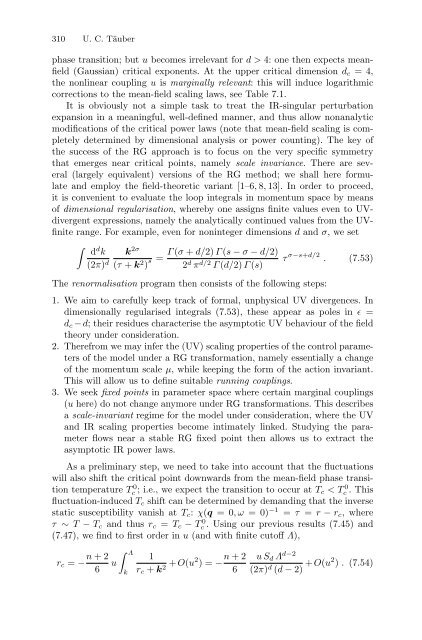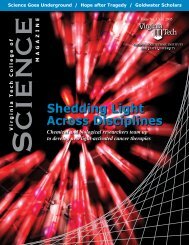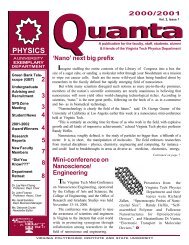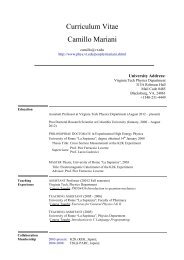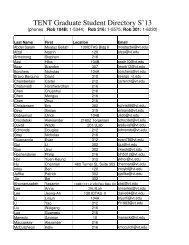Springer Lecture Notes in Physics 716
Springer Lecture Notes in Physics 716
Springer Lecture Notes in Physics 716
You also want an ePaper? Increase the reach of your titles
YUMPU automatically turns print PDFs into web optimized ePapers that Google loves.
310 U. C. Täuber<br />
phase transition; but u becomes irrelevant for d>4: one then expects meanfield<br />
(Gaussian) critical exponents. At the upper critical dimension d c =4,<br />
the nonl<strong>in</strong>ear coupl<strong>in</strong>g u is marg<strong>in</strong>ally relevant: this will <strong>in</strong>duce logarithmic<br />
corrections to the mean-field scal<strong>in</strong>g laws, see Table 7.1.<br />
It is obviously not a simple task to treat the IR-s<strong>in</strong>gular perturbation<br />
expansion <strong>in</strong> a mean<strong>in</strong>gful, well-def<strong>in</strong>ed manner, and thus allow nonanalytic<br />
modifications of the critical power laws (note that mean-field scal<strong>in</strong>g is completely<br />
determ<strong>in</strong>ed by dimensional analysis or power count<strong>in</strong>g). The key of<br />
the success of the RG approach is to focus on the very specific symmetry<br />
that emerges near critical po<strong>in</strong>ts, namely scale <strong>in</strong>variance. There are several<br />
(largely equivalent) versions of the RG method; we shall here formulate<br />
and employ the field-theoretic variant [1–6, 8, 13]. In order to proceed,<br />
it is convenient to evaluate the loop <strong>in</strong>tegrals <strong>in</strong> momentum space by means<br />
of dimensional regularisation, whereby one assigns f<strong>in</strong>ite values even to UVdivergent<br />
expressions, namely the analytically cont<strong>in</strong>ued values from the UVf<strong>in</strong>ite<br />
range. For example, even for non<strong>in</strong>teger dimensions d and σ, weset<br />
∫<br />
d d k<br />
(2π) d<br />
k 2σ Γ (σ + d/2) Γ (s − σ − d/2)<br />
(τ + k 2 ) s =<br />
2 d π d/2 Γ (d/2) Γ (s)<br />
The renormalisation program then consists of the follow<strong>in</strong>g steps:<br />
τ σ−s+d/2 . (7.53)<br />
1. We aim to carefully keep track of formal, unphysical UV divergences. In<br />
dimensionally regularised <strong>in</strong>tegrals (7.53), these appear as poles <strong>in</strong> ɛ =<br />
d c − d; their residues characterise the asymptotic UV behaviour of the field<br />
theory under consideration.<br />
2. Therefrom we may <strong>in</strong>fer the (UV) scal<strong>in</strong>g properties of the control parameters<br />
of the model under a RG transformation, namely essentially a change<br />
of the momentum scale µ, while keep<strong>in</strong>g the form of the action <strong>in</strong>variant.<br />
This will allow us to def<strong>in</strong>e suitable runn<strong>in</strong>g coupl<strong>in</strong>gs.<br />
3. We seek fixed po<strong>in</strong>ts <strong>in</strong> parameter space where certa<strong>in</strong> marg<strong>in</strong>al coupl<strong>in</strong>gs<br />
(u here) do not change anymore under RG transformations. This describes<br />
a scale-<strong>in</strong>variant regime for the model under consideration, where the UV<br />
and IR scal<strong>in</strong>g properties become <strong>in</strong>timately l<strong>in</strong>ked. Study<strong>in</strong>g the parameter<br />
flows near a stable RG fixed po<strong>in</strong>t then allows us to extract the<br />
asymptotic IR power laws.<br />
As a prelim<strong>in</strong>ary step, we need to take <strong>in</strong>to account that the fluctuations<br />
will also shift the critical po<strong>in</strong>t downwards from the mean-field phase transition<br />
temperature T 0 c ; i.e., we expect the transition to occur at T c


